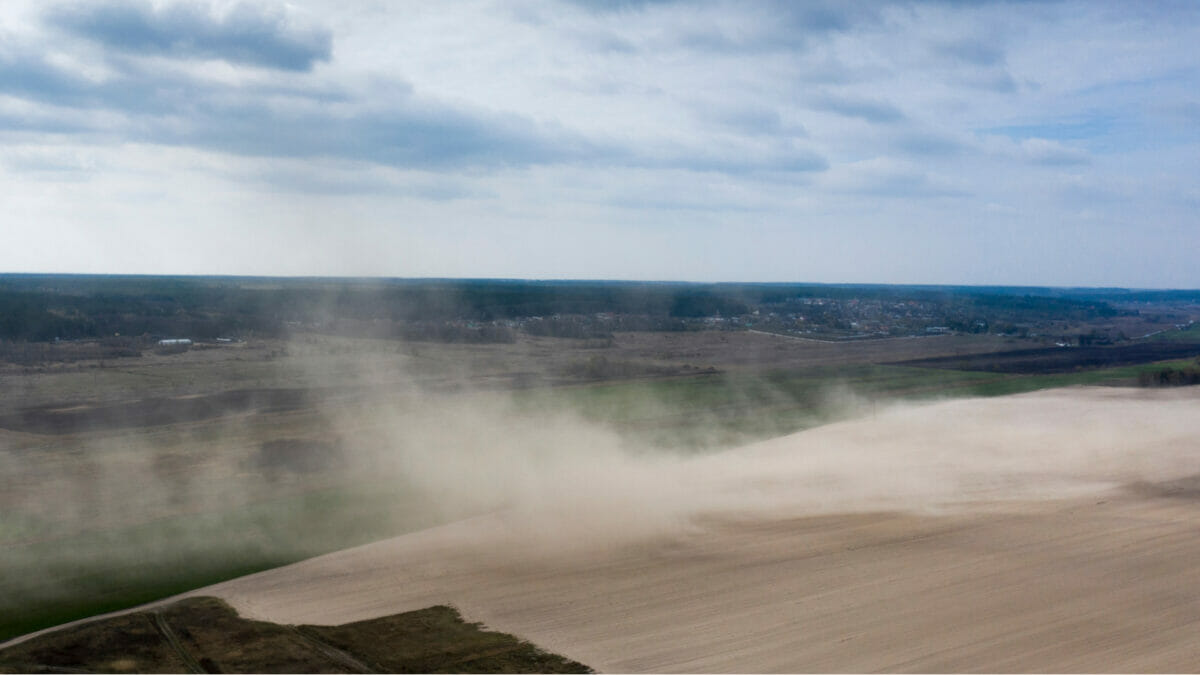Farmers aren’t just battling water issues. They’re losing topsoil, moisture and crop residue, on top of other wind-related issues.

When he looked out over his property in southwest Kansas this spring, Jim Sipes felt like he’d been transported back in time to the 1930s, when high winds and choking dust swept through the Midwest during the Dust Bowl.
“If you’ve ever watched a documentary about the Dust Bowl, that was about my neighbors,” says Sipes, a 55-year-old, fifth-generation farmer who primarily grows winter wheat and grain sorghum. “We know what hard times are like in this neck of the woods.”
Because of how dry and windy it’s been, most of Sipes’ winter wheat crop never even sprouted. What did come up, the wind “sandblasted” off, he says. And although he tilled the field behind his house five or six times in an effort to prevent the topsoil from blowing away (a drastic measure on his mostly no-till farm), those efforts didn’t do any good.
“The attitudes out here are terrible, especially for people who are living in a house where the neighbor can’t stop the dirt from blowing,” says Sipes. “It’s very, very depressing. We’re in the worst conditions I have seen.”
Sipes is just one of the many farmers and ranchers across the country grappling with fierce winds this spring. In Colorado, farmers are already prepared to battle fast-spreading wildfires spurred on by high winds at any moment, even though wildfire season typically doesn’t start until the middle of the summer. In parts of Texas, severe winds rendered many farmers’ winter wheat crops a total loss. And in Nebraska, South Dakota and parts of Iowa, a mid-May storm system with winds topping 80 miles per hour destroyed farm buildings and machinery.
RELATED: Agriculture’s Water Challenge Is About to Get a Lot Worse
But farmers’ wind-driven headaches go beyond one-off severe weather events and natural disasters. This spring, some regions have had dozens of consecutive days with winds topping 50 or 60 miles per hour, which make working outside utterly miserable. In addition, the relentless stream of air is sapping precious moisture from the already dry soil, blowing off highly nutritious topsoil, wreaking havoc on crop residue (the stalks and other plant matter left behind after harvest to help retain soil moisture and prevent erosion) and, in general, making a huge mess for farmers and their neighbors.
“It’s been exceptionally windy,” says Steve Benzel, a 63-year-old farmer in western Nebraska. “Most people I talk to don’t ever remember there being this many consecutive days of that high of winds. Mother Nature has not been nice.”
For Benzel, a third-generation grower who farms corn, sugar beets, wheat, edible beans and some field peas, the wind dried out fields that were already parched from a lack of snow this winter. On top of that, the wind blew off much of his topsoil, the fertile uppermost layer of soil that provides nutrients and minerals to plants. Because the winds came in the spring, when he hadn’t yet planted for summer, there was nothing in the ground to help hold the soil in place.
“If there was an opening, it had dirt in it,” he says. “If you think of the surface of the Earth as an apple, the topsoil is the skin. In this area, we might have four to six inches of topsoil and, last month, we probably lost a pretty good percentage of that. So, basically, that sets the time clock way back to regenerate the topsoil these fields lost.”
Grower Marc Arnusch counted 20 consecutive days of high winds on his Colorado farm, which contributed to “the worst wheat crop we’ve ever had in our farm’s history,” he says. Not only did the wind dry out the soil, but it also stunted the crop’s leaf growth by whipping the foliage around not long after it emerged.
“Just like you and me, when you stand out in the wind, you get tired, you get rundown—the crop is very much the same way,” he says, adding that this is one of the windiest springs he’s experienced in his 30 years of farming.
And, like something out of a science fiction novel, the wind also created static electricity that essentially electrocuted some of the plants, according to Arnusch. “I don’t know that there’s anything positive about wind—if there is, I don’t know what that is,” he says.
RELATED: How Technology is Changing Agriculture Work
He also lost several fields of seed barley and the wind knocked over his 40-foot-tall real-time kinematic (RTK) tower, which makes it possible for equipment to steer and drive autonomously on fields up to seven miles away.
“The wind wiggled it back and forth like a first grader’s front tooth and eventually it just gave way in the middle of the night,” says Arnusch, who farms 2,200 acres of corn for grain and silage, seed wheat and barley, alfalfa and wheat and barley for breweries and distilleries. “The tower was laying in pieces when we came in to work the next day.”
The windy spring has the potential to delay the maturity of Arnusch’s crops, which then leaves the plants vulnerable to other stresses, such as hail. But, even though he’s worried about the wind, supply chain issues, the lack of water in the West and other issues, Arnusch—like nearly every other farmer on the planet—is somehow finding a way to stay positive.
“I learned a long time ago that, to be a successful farmer, you have to be an eternal optimist,” he says. “It’s best for peace of mind to look for some positives or to look at it as a challenge when you have spring conditions like this.”